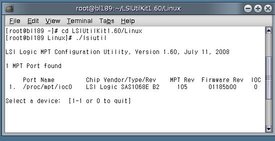| Exit Print View | |
Sun Blade 6000 Disk Module Administration Guide |

|
1. Overview of Using Sun Blade 6000 Disk Modules With Server Modules
2. Inserting, Moving and Replacing the Sun Blade 6000 Disk Module
5. Installing, Removing or Replacing Disks
7. How LSI Host Bus Adapters Assign Target IDs to Expanders, Disks, and RAID Volumes
8. How Adaptec Host Bus Adapters Assign Target IDs to Expanders, Disks, and RAID Volumes
9. Setting Up Hardware RAID Volumes With LSI and Adaptec Host Bus Adapters
10. ILOM For the Sun Blade 6000 Disk Module
11. Oracle's Sun Storage Common Array Manager (CAM)
A. Using the SIA Application to Upgrade x86 Server Blade and Host Bus Adapter Firmware
Where to Obtain the lsiutil Software
To Use lsiutil From the Command Line
To Use the Interactive lsiutil Menus
Why Save LSI Host Bus Adapter Persistent Mappings?
When to Save LSI Host Bus Adapter Persistent Mappings
Saving and Restoring a Persistence Map
To Save a Snapshot of Your Host Bus Adapter Persistent Mappings
C. Upgrading the Disk Module to Allow a SAS-2 Compatible Server Blade in the Chassis
The stored snapshot files are used when a host bus adapter fails and must be replaced. They are not needed for any other purpose.
Note - Unless your OS is installed on a single disk on your server blade, or a RAID volume with at least one member disk installed on your server blade (always true for SPARC systems, for example), you need to reboot with an external OS (a bootable DOS disk is preferred, if possible) to perform this procedure.
To restore the persistent mappings from a previously saved snapshot file (for example, HBA33_persistance_file), do the following:
Make sure that your saved the persistence mappings snapshot file in the same directory as the lsiutil software you are using. Copy the file from external media if necessary.
Run lsiutil in interactive mode (see ![]() To Use the Interactive lsiutil Menus).
To Use the Interactive lsiutil Menus).

Type 1 and press Enter.
The basic (incomplete) interactive menu opens.
Tip - You cannot see all the commands in the menu, but you can enter any command number if you know what it is. In our case we want to open the Persistence menu. This is done with command 15.
Type 15 and press Enter.
The Persistence menu opens.

Type 10 and press Enter.
This clears any persistence map that is present in the host bus adapter.

Type 8 and press Enter.
You are prompted for the name of a persistent mappings snapshot file to load.
Type the name of the snapshot file. For example, HBA33_persistence_file.

Press Enter.
The persistence map is loaded. lsiutil confirms that four persistence entries were loaded.

Type 0 (zero) and press Enter three times to exit lsiutil.
Note - The adapter persistent mappings snapshot file you just loaded is still valid. Make sure that you save a copy of it on external media.